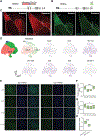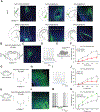An amygdalar oscillator coordinates cellular and behavioral rhythms
- PMID: 39303704
- PMCID: PMC11581920
- DOI: 10.1016/j.neuron.2024.08.013
An amygdalar oscillator coordinates cellular and behavioral rhythms
Abstract
Circadian rhythms are generated by the master pacemaker suprachiasmatic nucleus (SCN) in concert with local clocks throughout the body. Although many brain regions exhibit cycling clock gene expression, the identity of a discrete extra-SCN brain oscillator that produces rhythmic behavior has remained elusive. Here, we show that an extra-SCN oscillator in the lateral amygdala (LA) is defined by expression of the clock-output molecule mWAKE/ANKFN1. mWAKE is enriched in the anterior/dorsal LA (adLA), and, strikingly, selective disruption of clock function or excitatory signaling in adLAmWAKE neurons abolishes Period2 (PER2) rhythms throughout the LA. mWAKE levels rise at night and promote rhythmic excitability of adLAmWAKE neurons by upregulating Ca2+-activated K+ channel activity specifically at night. adLAmWAKE neurons coordinate rhythmic sensory perception and anxiety in a clock-dependent and WAKE-dependent manner. Together, these data reveal the cellular identity of an extra-SCN brain oscillator and suggest a multi-level hierarchical system organizing molecular and behavioral rhythms.
Keywords: SCN; anxiety; circadian; clock; lateral amygdala; local clock; mWAKE; rhythm; touch.
Copyright © 2024 Elsevier Inc. All rights reserved.
Conflict of interest statement
Declaration of interests The authors declare no competing interests.
Figures







References
MeSH terms
Substances
Grants and funding
LinkOut - more resources
Full Text Sources
Molecular Biology Databases
Miscellaneous

